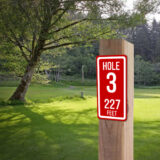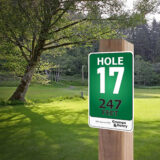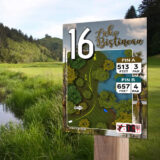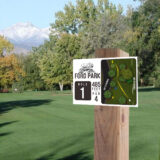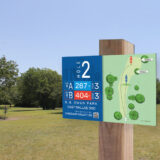In the world of disc golf, the interplay between players and the environment is a defining characteristic. Trees, with their majestic presence, are not just passive spectators but active participants in the strategic dance of the game. As disc golf courses evolve, the loss of trees becomes a poignant reality, impacting not only the visual appeal but also the playability of the courses. In this blog post, we’ll explore the strategic significance of trees in disc golf courses, the reasons behind their decline, and the call to action for planting trees strategically to enhance both the gameplay and the enduring legacy of the sport.
The Arboreal Tapestry:
Disc golf courses are more than just a layout of baskets and fairways; they are living ecosystems where trees play a crucial role. Trees are not only obstacles that challenge players’ skills but also provide aesthetic beauty, natural shade, and a habitat for wildlife. The strategic placement of baskets around trees adds an element of tactical decision-making, transforming the game into a harmonious blend of skill and nature.
Causes for Tree Loss:
As disc golf courses mature, various factors contribute to the decline of trees:
- Natural Aging: Trees, like all living organisms, have a lifespan. As they age, they become susceptible to diseases, pests, and environmental stressors that can lead to their decline.
- Weather Events: Severe weather events, from storms to hurricanes, can cause significant damage to trees, necessitating their removal for safety reasons.
- Land Development: Urban expansion or changes in land use may result in the removal of trees to accommodate new construction projects or infrastructure.
- Disease and Pests: Outbreaks of diseases or infestations by pests can impact tree health, making it necessary to remove affected trees to prevent the spread of these issues.
Strategic Tree Planting: Enhancing Playability and Aesthetics:
- Define Fairways: Planting trees strategically can define fairways and shape the intended flight path for different holes. This not only adds a layer of challenge but also guides players through a thoughtfully designed course layout.
- Create Risk-Reward Scenarios: Intentionally placing trees can create strategic decision points for players. Should they navigate a narrow gap between trees for a potentially shorter route or opt for a safer, but longer, path?
- Enhance Scenic Beauty: Beyond their functional role, strategically planted trees contribute to the visual appeal of the course. A well-designed course becomes a symphony of greenery, providing a tranquil and immersive experience for players.
Empowering Future Generations:
As stewards of the sport, disc golfers today have the power to shape the future of the game. Beyond lamenting the loss of trees, there’s an opportunity to actively contribute to the enhancement of disc golf courses. By strategically planting trees, we:
- Preserve Strategic Challenges: Planting trees strategically preserves the strategic essence of the game, maintaining the challenge, and ensuring that each throw requires careful consideration.
- Foster Community Engagement: Tree planting initiatives can bring disc golf communities together, fostering a shared sense of responsibility for the courses they cherish.
- Leave a Living Legacy: The trees we plant today will become the strategic guardians of the game for future generations, weaving a living legacy into the very fabric of disc golf history.
In the evolving landscape of disc golf courses, trees stand not only as guardians of the game but as active participants in its strategic unfolding. As we witness changes in our beloved courses, let us not mourn the loss but instead sow the seeds for a greener, more strategically nuanced future. By planting trees with intention and foresight, we ensure that disc golf remains a dynamic interplay between skill, strategy, and nature—a legacy for future generations to enjoy and cherish. So, let’s pick up our discs and strategically plant the seeds of a flourishing disc golf landscape—one thoughtfully placed tree at a time.

